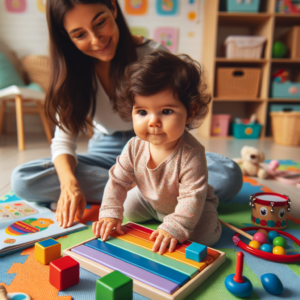Developing motor skills is a crucial part of your babygirl’s growth and development. These skills, which include both gross motor (large movements) and fine motor (small, precise movements) abilities, form the foundation for her physical interactions with the world. This comprehensive guide will help you understand motor skill development and provide exercises and activities to support your babygirl’s physical growth.
Understanding Motor Skill Development
Motor skills develop in a predictable pattern, typically from head to toe and from the center of the body outward:
Gross Motor Milestones:
- 0-3 months: Lifts head when on tummy
- 3-6 months: Rolls over, sits with support
- 6-9 months: Sits without support, may start crawling
- 9-12 months: Pulls to stand, cruises furniture
- 12-18 months: Walks independently, climbs stairs
Fine Motor Milestones:
- 0-3 months: Brings hands to mouth, grasps reflexively
- 3-6 months: Reaches for and grasps objects
- 6-9 months: Transfers objects between hands
- 9-12 months: Uses pincer grasp (thumb and forefinger)
- 12-18 months: Stacks blocks, scribbles with crayon
Exercises and Activities for Gross Motor Skills
- Tummy Time
- Place your babygirl on her tummy for short periods while awake
- Use toys to encourage lifting her head and reaching
- Assisted Rolling
- Gently guide your babygirl from her back to her side
- Encourage her to complete the roll on her own
- Sitting Practice
- Support your babygirl in a sitting position
- Gradually reduce support as she gains strength
- Crawling Encouragement
- Place toys just out of reach during tummy time
- Create safe “obstacle courses” for her to navigate
- Pull-to-Stand Practice
- Offer your hands or sturdy furniture for support
- Encourage her to pull herself up to standing position
- Cruising and Walking
- Arrange furniture to create a “cruising route”
- Hold her hands and encourage walking steps
- Stair Climbing (with supervision)
- Allow her to practice climbing a few steps
- Always stay close for safety
Exercises and Activities for Fine Motor Skills
- Grasping Practice
- Offer safe objects of various sizes and textures
- Encourage her to reach and grasp
- Object Transfer
- Demonstrate moving objects from one hand to the other
- Offer small, safe objects for her to practice with
- Pincer Grasp Development
- Offer small, safe objects like cereal pieces
- Encourage her to pick them up with thumb and forefinger
- Stacking and Building
- Provide soft blocks or cups for stacking
- Demonstrate and encourage building simple structures
- Finger Foods
- Offer safe finger foods to encourage self-feeding
- This naturally practices the pincer grasp
- Simple Puzzles
- Use chunky, single-piece puzzles
- Help guide pieces into place
- Scribbling and Drawing
- Offer large crayons and paper
- Encourage free scribbling
Creating a Motor-Skill-Friendly Environment
- Safe Exploration Space
- Create a baby-proofed area for free movement
- Include a variety of textures and safe obstacles
- Varied Surfaces
- Provide opportunities to move on different surfaces (carpet, hardwood, grass)
- This helps develop balance and coordination
- Appropriate Toys
- Offer toys that encourage reaching, grasping, and manipulation
- Rotate toys to maintain interest
- Minimal Use of Restrictive Equipment
- Limit time in swings, bouncy seats, etc.
- These can restrict natural movement and exploration
The Importance of Sensory Integration
Motor skills develop hand-in-hand with sensory processing:
- Provide a variety of sensory experiences (different textures, sounds, sights)
- Engage in sensory play (water play, sand play, finger painting)
- Incorporate movement into daily routines (bouncing, swinging, rocking)
Frequently Asked Questions
Q: My babygirl isn’t crawling at 9 months. Should I be worried? A: Every baby develops at their own pace. Some babies skip crawling altogether. If you’re concerned, consult your pediatrician.
Q: How much tummy time should my newborn have? A: Start with short sessions (1-2 minutes) several times a day, gradually increasing as your baby tolerates it.
Q: Can I help my babygirl learn to walk faster? A: It’s best to let walking develop naturally. Provide opportunities for cruising and supported walking, but don’t rush the process.
Q: Are walker devices helpful for motor development? A: The American Academy of Pediatrics advises against walker devices, as they can delay motor development and pose safety risks.
Conclusion
Supporting your babygirl’s motor skill development is an exciting journey filled with milestones and achievements. Remember that every baby develops at their own pace, and it’s important to celebrate each step along the way.
By providing a safe, stimulating environment and engaging in activities that support both gross and fine motor skills, you’re helping your babygirl build the physical foundation she needs to explore and interact with the world around her.
As you engage in these exercises and activities, pay attention to your babygirl’s cues. Follow her lead, offer encouragement, and most importantly, have fun together! These early experiences of movement and exploration are not just about physical development—they’re also building her confidence, curiosity, and joy in physical activity.
Remember, you’re your babygirl’s first and most important “coach” in developing her motor skills. Your patience, encouragement, and loving support are the most valuable tools in helping her grow into a physically capable and confident little person. Enjoy this special time of growth and discovery with your babygirl!



